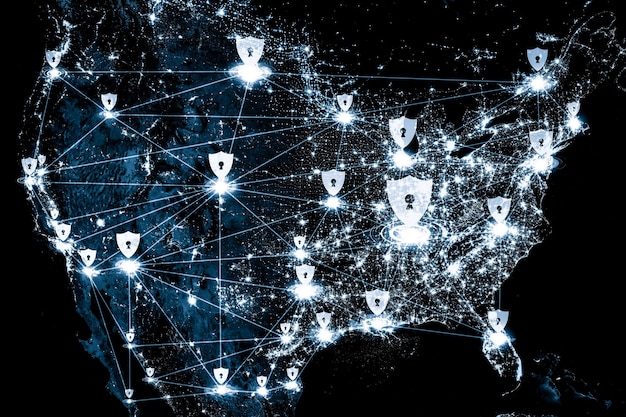Network TV’s Fight Against Piracy: Technologies and Strategies

Network TV faces ongoing piracy challenges, necessitating advanced technologies and strategic approaches, including DRM, watermarking, legal action, and content monitoring, to protect revenue and maintain content integrity in an evolving digital landscape.
The battle against piracy is a never-ending saga for network television. As content distribution evolves, so do the methods of piracy, making it crucial for networks to adopt cutting-edge technologies and robust strategies to protect their intellectual property. This article dives into the heart of **Network TV’s Battle Against Piracy: New Technologies and Strategies to Protect Content**, exploring the multi-faceted approaches being employed to safeguard television’s future.
The Evolving Threat of TV Piracy
Piracy is not a new phenomenon, but its impact on network television has been amplified in the digital age. The accessibility of high-speed internet and the proliferation of streaming devices have made it easier than ever for illegal content to be distributed and consumed. Understanding the forms this piracy takes is the first step in combating it.
Common Forms of TV Piracy
Network television faces a range of piracy methods, each requiring a specific countermeasure. From unauthorized streaming to illegal downloads, the industry must stay ahead of these evolving threats.
- Unauthorized Streaming: Illegal streaming services offer access to pirated content, often mimicking legitimate platforms.
- Illegal Downloads: Users download copyrighted content from unofficial sources, circumventing legal distribution channels.
- Copyright Infringement: Broadcasting or distributing content without proper authorization.
In today’s media consumption landscape, the sophisticated nature of tools used by infringers poses a substantial threat to network television’s revenue streams and content exclusivity.

Technologies for Content Protection
Several technologies are at the forefront of protecting network TV content. These tools offer varying levels of security, from preventing unauthorized access to tracking illegal distribution.
Digital Rights Management (DRM)
DRM technologies control access to copyrighted material. By encrypting digital content, DRM ensures that only authorized users can view or access it.
- Encryption: Making content unintelligible without a decryption key.
- License Management: Controlling how users can access and use the content.
- Device Authorization: Ensuring only authorized devices can play the content.
Advanced DRM systems are dynamically adapting as piracy techniques become more sophisticated. They are critical for securing content across various platforms and devices.
Watermarking and Content Tracking
Watermarking involves embedding a unique identifier into content, making it possible to trace the source of piracy. These identifiers are often invisible to the naked eye, yet they provide valuable data for tracking and legal action.
Applying Watermarks Effectively
Effective watermarking requires careful planning and implementation. The watermark must be robust enough to survive various forms of manipulation, such as format conversion or compression.
- Visible Watermarks: Easily identifiable but potentially distracting.
- Invisible Watermarks: Discreet but require specialized tools to detect.
- Forensic Watermarks: Unique identifiers that trace each copy of the content.
Watermarking, combined with robust content tracking systems, empowers networks to identify and take action against piracy sources swiftly.

Legal Strategies and Enforcement
While technology plays a crucial role, legal strategies provide the backbone needed to enforce copyright laws. Legal action can deter piracy and hold infringers accountable for their actions.
Legal Avenues for Content Protection
Networks are increasingly turning to the courts to protect their content. These legal battles can be costly and time-consuming, but they send a clear message that piracy will not be tolerated.
- Copyright Lawsuits: Suing individuals or organizations involved in piracy.
- DMCA Takedown Notices: Demanding the removal of infringing content from websites and online platforms.
- Criminal Prosecution: Pursuing criminal charges against large-scale piracy operations.
The effectiveness of legal strategies relies heavily on global collaboration and streamlined international copyright laws to address piracy happening across borders.
Collaboration and Industry Initiatives
Combating piracy requires a united front. Collaboration among networks, technology providers, and government agencies is essential to developing effective solutions.
The Power of Industry Alliances
Industry alliances foster information sharing and the development of best practices. By working together, networks can pool resources and expertise to combat piracy more effectively.
- Information Sharing: Sharing piracy trends and effective countermeasures.
- Joint Research: Collaborating on research to develop new technologies.
- Lobbying Efforts: Advocating for stronger copyright laws.
When industry players work in unison, they’re better suited to tackle the multifaceted challenges posed by modern-day piracy.
Content Monitoring and Threat Intelligence
Proactive monitoring of online platforms and dark web networks is crucial to discover and mitigate piracy incidents before they escalate. Sophisticated threat intelligence systems can identify emerging threats and provide actionable insights.
Effective Content Monitoring Strategies
Effective content monitoring requires a combination of automated tools and human expertise. These strategies help networks stay one step ahead of pirates.
- Automated Scanning: Using software to scan the internet for infringing content.
- Human Review: Manually reviewing content flagged by automated systems.
- Dark Web Monitoring: Tracking piracy activities on underground networks.
By gathering and analyzing threat intelligence, networks can anticipate and neutralize piracy threats before substantial damage occurs.
| Key Aspect | Brief Description |
|---|---|
| 🛡️ DRM Technologies | Controls access to copyrighted network TV content, ensuring only authorized users can access. |
| 🎯 Watermarking | Embeds unique identifiers into content to trace the source of piracy. Useful for tracking and legal action. |
| ⚖️ Legal Enforcement | Utilizes copyright lawsuits and DMCA takedown notices. Prosecuting large-scale piracy operations. |
| 🤝 Industry Collaboration | Networks collaborate through information sharing, research, and lobbying efforts to strengthen copyright laws. |
Frequently Asked Questions (FAQ)
▼
Digital Rights Management (DRM) refers to technologies used to control access to copyrighted material, ensuring only authorized users can access the content. Encryption, license management, and device authorization are involved.
▼
Watermarking involves embedding a unique identifier into content to trace the source of piracy. These identifiers, visible or invisible, provide data for tracking and legal action against sources.
▼
Networks can pursue legal avenues such as copyright lawsuits, DMCA takedown notices to remove infringing content, and collaborating with authorities on criminal prosecution against large-scale piracy operations.
▼
Collaboration fosters information sharing and the development of best practices, enabling networks to pool resources and expertise. This collaboration is essential for proactively and effectively combating piracy trends.
▼
Threat intelligence uses proactive monitoring of online platforms and dark web networks to identify piracy and mitigate incidents. This data assists networks neutralize threats before they grow.
Conclusion
In conclusion, the fight against piracy in network television is a dynamic, ongoing effort. By incorporating cutting-edge technologies, pursuing legal avenues, fostering collaboration, and monitoring content effectively, networks can defend their intellectual property and ensure the long-term viability of the industry.





